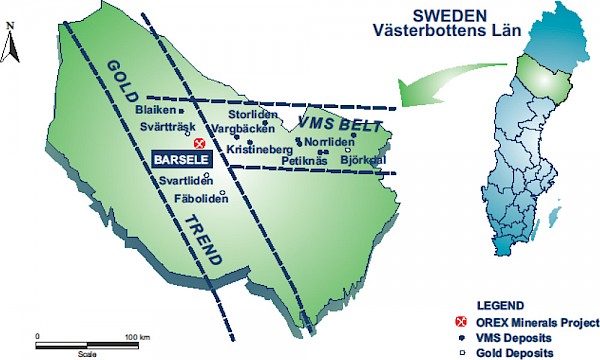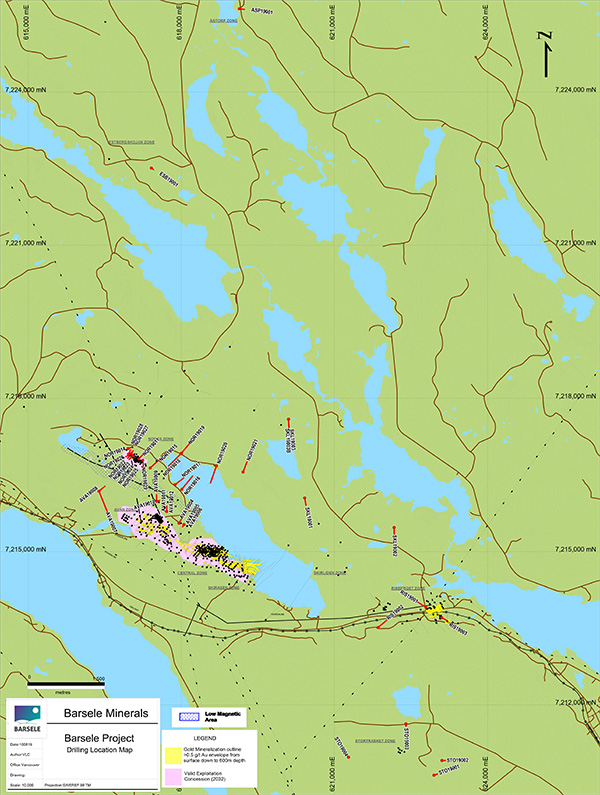Our 45% owned Barsele Gold Project is located approx. 600 km due north of Stockholm and 20 km southeast of Storuman, a small town situated in Västerbottens Län, which is a regional district of Northern Sweden. There is also potential for polymetallic VMS deposits within the claims. Our total mineral claim holdings are over 47,000 hectares.
Since Agnico Eagle became operator of the project in late 2015, a total of 155,345 metres of overburden penetration and core collection has been tabulated from a total of 404 drill holes. An additional 414 holes were drilled by previous operators.The majority of the drilling has been focused on defining, verifying and expanding the mineral resources within the Avan-Central-Skiråsen (CAS) “Orogenic Gold” system and more recently the Risberget Zone. During 2019, drilling was primarily focused on the discovery of massive sulphide mineralization that is hosted in rocks of volcanic and sedimentary composition along with post mineral intrusive dykes and sills. The historic Norra VMS deposit within the claims is an example of this style of mineralization.
Several major gold deposits are situated nearby, including: Bjorkdal (Elgin Mining), Faboliden (Dragon Mining) and Svartliden (Dragon Mining). Major polymetallic VMS deposits are also nearby, including Kristineberg (Boliden Mining).

Click to enlarge

Click to enlarge

...
WHY SWEDEN?
- Sweden is one of Europe's leading producers of metals with a long & successful history of mining
- 1992 - revised mining law abolished Statutory State holdings for mineral projects, which opened door to foreign investment in mining
- Many local & international companies actively exploring and/or currently developing mines
- Taxation incentives for project development from local & regional governments
- 22% corporate tax rate and no mineral tax
- low mineral license costs & good security of tenure
- Well-developed access & infrastructure
- power, rail, roads, telecommunications, water
- skilled local labour market
- Low political risk in Sweden
- few impediments to exploration & development of a project
- mature, well-defined environmental requirements & permitting process
CURRENT AGNICO EAGLE WORK PLAN
- Ongoing diamond drill program - planned by Agnico Eagle for 2021
- Diamond drill testing of new anomalous areas within the CAS, gold zone as well as massive sulphide targets - prospecting, mapping, geophysics, till sampling
- Environmental studies & compliance - ongoing
GEOLOGY
Property Description and Location
The Barsele gold project (the "Project" or the "Property") is situated adjacent to Barsele, a small town in Västerbottens Län (County) in Northern Sweden. It is located approximatively 20 kilometres east-southeast from the town of Storuman. Barsele lies 200 kilometres northwest of Umeå (population of 120,000), the administrative headquarters of the county, and approximatively 630 kilometres north of Stockholm. The geographic coordinates of the Project are latitude 65°02' North and longitude 17°30' East. (UTM coordinates 621349E, 7217734N: SWEREF99 TM).
The Barsele Project currently consists of one block of 23 granted exploration permits and two (2) exploitation concessions issued by the Chief Mining Inspector, for an aggregate area of 43,481.96 ha (434.8196 km2). Fifteen (15) exploration permits are registered in the name of Gunnarn Mining and five (5) in the name of AE Sweden. Applications have been submitted for one (1) exploration permit for an area of 3,789.71 ha (37.90 km2), registered in the name of AE Sweden.
Geology
The Barsele Project is located within Paleoproterozoic supracrustal and associated intrusive rocks of the Fennoscandian Shield. Bedrock in the district consists of 1.96-1.86 Ga volcanic and sedimentary rocks associated with the Svecofennian domain and intrusive rocks of 1.96-1.80 Ga that were deformed and metamorphosed simultaneously during the Svecokarelian orogeny. The lowest stratigraphic unit in the district consists of metasedimentary and intercalated volcanic rocks of the Bothnian Supergroup, the inferred basement to the mainly felsic volcanic rocks of the Skellefte Group. The Skellefte Group is overlain in the Skellefte district, by a dominantly sedimentary unit called the Vargfors Group. Early orogenic rocks are suggested to be co-magmatic with the volcanic rocks of the Skellefte Group. Younger phases of intrusives are assigned to the Perthite-Monzonite suite and post-date the deposition of the volcanic rocks.
The project area is located at the intersection of the Skellefte-belt and the Gold Line metallogenic trend in Sweden, a northwest-southeast geochemical gold anomaly outlined in a regional till survey, now with numerous known Au deposits along with former and producing mines. The project area covers a sequence of metasedimentary and volcanic rocks of the Proterozoic Svecofennian system. The volcanics are more specifically referred to as the Härnö Formation. The metasedimentary rocks consist of metamorphosed greywackes and pelites and sporadic conglomerates. The volcanic rocks of the Härnö Formation consist of felsic, intermediate and mafic volcanics, including pillow lavas and pyroclastics, probably deposited in a back-arc setting.
There are three main phases of granitoid intrusions in the region which are referred to as early, middle and post with respect to the Svecofenian orogeny. The early orogenic granitoids are the most important from a mineralization perspective and comprise a calc-alkaline suite of predominantly tonalites with lesser volumes of granodiorite, which were emplaced prior to the main phases of Svecofennian metamorphism and deformation. An early orogenic granodiorite is the host rock of the Central Avan and Skiråsen mineralized zones at Barsele. In detail, at least seven separate intrusive pulses have been identified at the Central Avan and Skiråsen zones including late and post-mineralization dykes. The granodiorite exhibits a well-developed S2 penetrative foliation which is cut by ductile shear zones, faults, fractures and dilational quartz and quartz-carbonate sulphide veining. The granodiorite is quartz-feldspar phyric and is composed of sericitized plagioclase, quartz, biotite and lesser K-feldspar. The highly fractured granodiorite ranges in width from 200 m to 500 m with an intermittent strike-extent exceeding 8 km. The intrusion bends from an east-west orientation in the east to a northwest trend in the west, where the three major zones of gold mineralization have been identified.
The gold-rich volcanic-hosted, semi-massive to massive sulphide style of mineralization at the Norra Zone is quite distinct from the mesothermal intrusive-hosted gold mineralization of the Avan Central Skiråsen zones. The Norra Zone occurs within a lens of felsic metavolcanics and pelitic sediments of the Härnö Formation. The lithologies consist of a WNW-trending, steeply dipping sequence of dacitic to rhyolitic flows, felsic volcaniclastics and fine-grained tuffs. The mineralized host-lithology appears to be a quartz-phyric volcaniclastic unit. Alteration is characterized by a network of veinlets and discontinuous patches of sulphides, chlorite and carbonate. The host rock is cut by felsic and mafic intrusions which are probably sills. It is likely that intrusions range in timing from pre- to syn to post sulphide mineralization.
Mineralization
Mineralization varies among the zones on the Property. Two distinct mineralized areas have been explored on the Barsele concessions: CAS (the Avan, Central, and Skiråsen zones) and Norra.
The Central, Avan and Skiråsen zones have a combined strike length of 2.7 km. The Central Zone comprises 24 lodes (14 D2 type and 10 D3 type) and the Skiråsen Zone hosts 13 lodes (D2 type) with an average horizontal thickness of 5 m for D3 type and 10 m for D2 type. Some of the lodes have to date been traced to a depth of 900 m. The Avan zone consist of 22 lodes (D2 type) with an average horizontal thickness of 10 m. The lodes can be followed for 800 m along strike and up to 700 m depth. Several events of shearing and veining occur through the deposit, with early ductile emplacement of tourmaline-rich sulphide-poor veins predating the emplacement of gold bearing mineralization commonly hosted by quartz ± calcite veins.
Based on their texture and mineralogy, the gold-bearing quartz veins have been classified into: Qtz-1 ductile quartz veins with altered sulphidized haloes, Qtz-2 are quartz-calcite veins, Qtz-3 quartz veins containing visible gold, and Qtz-4 are auriferous sulphide-rich (sphalerite>pyrrhotite>galena) quartz veins. Gold mineralization is mainly hosted by Qtz-2 and Qtz-3 veins. Traces of pyrite and arsenopyrite are commonly observed.
Gold occurs as native metal alloyed with silver and demonstrates a general association with arsenopyrite, also occurring with pyrrhotite, calcite, chlorite, tourmaline and biotite. Base metal content of the deposit is typically low, although gold is seen to occur with sphalerite, galena, chalcopyrite, scheelite and rarely molybdenite. Sulphide, carbonate and quartz-tourmaline veinlets are locally mineralized. The host-granodiorite contains probably less than 2% disseminated fine-grained sulphides occurring as arsenopyrite, pyrrhotite and pyrite (Barry et al., 2006).
Norra Zone
The Norra Zone is a volcanic-sedimentary-hosted massive sulfide (VMS) regionally referred to as Skellefte-style. The main mineralized body is approximately 300 metres along strike and 5 to 50 meters in width. Gold is associated with the basal semi-massive arsenopyrite, pyrrhotite, chalcopyrite, galena, and sphalerite mineralization within a sequence of sheared felsic volcanics, foliated pyritic shales and pelitic sediments. Gold is probably remobilized and likely enriched by a later overprinting epithermal phase of mineralization.
